
The 1st Field Artillery Regiment (Mountain) (Italian: 1° Reggimento Artiglieria Terrestre (montagna)) is a field artillery regiment of the Italian Army, specializing in mountain warfare. The regiment is based in Fossano in Piedmont and assigned to the Alpine Brigade "Taurinense". The regiment is the Italian Army's senior mountain artillery regiment as it was formed in 1887 by the Royal Italian Army. In World War I the regiment's groups and batteries served on the Italian front.

The 3rd Field Artillery Regiment (Mountain) (Italian: 3° Reggimento Artiglieria Terrestre (montagna)) is a field artillery regiment of the Italian Army, specializing in mountain warfare. The regiment is based in Remanzacco in Friuli-Venezia Giulia and assigned to the Alpine Brigade "Julia". The regiment was formed in 1909 by the Royal Italian Army as 2nd Mountain Artillery Regiment. In World War I the regiment's groups and batteries served on the Italian front.

The Cavalry Brigade "Pozzuolo del Friuli" is a brigade of the Italian Army, based in the Friuli-Venezia Giulia and Veneto regions. The Brigade consists of a command unit, a cavalry regiment, an amphibious infantry regiment, an artillery regiment, an engineer regiment and a logistic regiment.

The 20th Infantry Division "Friuli" was an infantry division of the Royal Italian Army during World War II. The Friuli was formed on 24 August 1939 by splitting the 20th Infantry Division "Curtatone e Montanara" into the Friuli and the 44th Infantry Division "Cremona". The Friuli was named for the region of Friuli, but based in Tuscany, where it also recruited most of its troops. The division's headquarter and its regiments, with the exception of the 87th Infantry Regiment located in Siena, were based in Livorno. The division served as occupation force on Corsica and fought German units after the Armistice of Cassibile was announced on 8 September 1943. The division then served with the Italian Co-belligerent Army and remained active into the early stages of the Cold War.

The Armored Brigade "Vittorio Veneto" was an armored brigade of the Italian Army. Its core units were armored and mechanized cavalry squadrons groups. The brigade's headquarters was in the city of Villa Opicina, with most of its units based in the Province of Trieste. The brigade's name was chosen to remember the decisive Italian World War I victory at the Battle of Vittorio Veneto.
With the 1975 reforms the Italian Army abolished the regimental level and replaced it with brigades made up of multiple arms. During the reform the army disbanded 48 regimental commands and reduced its force by 87 battalions. A further ten regimental commands were used to raise ten new brigade commands. Ten training centers, which for traditional reasons had carried the names of regiments, were also disbanded. The reduction in units also allowed to mechanize most of the remaining units in Northern Italy and Italy's defense strategy changed from a hold-at-all-costs territorial defense to one of mobile warfare.

The 132nd Field Artillery Regiment "Ariete" is a field artillery regiment of the Italian Army, specializing in armored combat. Originally an armored artillery regiment of the Royal Italian Army, the regiment was assigned during World War II to the 132nd Armored Division "Ariete", with which it fought in the Western Desert campaign until the division and regiment were destroyed in the Second Battle of El Alamein.

The 21st Field Artillery Regiment "Trieste" is a field artillery regiment of the Italian Army. Today the regiment is based in Foggia in Apulia and assigned to the Mechanized Brigade "Pinerolo". Originally an artillery regiment of the Royal Italian Army, the regiment was formed in 1888 and served in World War I on the Italian front. In 1935 the regiment was assigned to the 8th Infantry Division "Po", which in 1939 was renamed 101st Motorized Division "Trieste". The division participated in the Greco-Italian War, fought in the Western Desert campaign and was forced to surrender to allied forces on 12 May 1943 at the end of the Tunisian campaign.
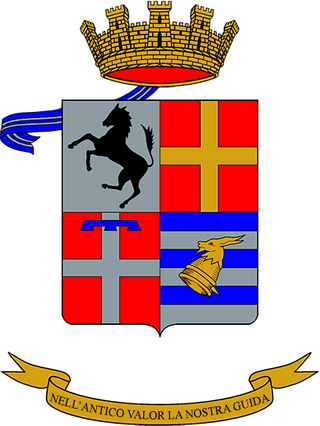
The 24th Field Artillery Regiment "Peloritani" is a field artillery regiment of the Italian Army. Today the regiment is based in Messina in Sicily and assigned to the Mechanized Brigade "Aosta". Originally an artillery regiment of the Royal Italian Army, the regiment was formed in 1888 and served in World War I on the Italian front. In 1935 the regiment was assigned to the 29th Infantry Division "Peloritana", which fought in the Second Italo-Ethiopian War. In 1939 the division was renamed as the 29th Infantry Division "Piemonte". The division participated in the Greco-Italian War and then remained in Yugoslavia on anti-partisan duty. The division and regiment were located on the Peloponnese peninsula, when the Armistice of Cassibile was announced on 8 September 1943. The division and its units surrendered to attacking German forces on 11 September.
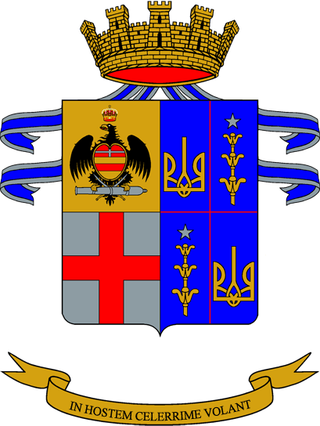
The Field Artillery Regiment "a Cavallo" is a field artillery regiment of the Italian Army. The regiment carries and maintains the traditions of all Royal Sardinian Army, Royal Italian Army and Italian Army horse artillery units and includes a historic section with horse-drawn guns. The Royal Sardinian Army formed the first horse batteries in 1831, which in 1887 were merged to create the Horse Artillery Regiment. In World War I the regiment's batteries were assigned to the Royal Italian Army's four cavalry divisions, which fought on the Italian front.
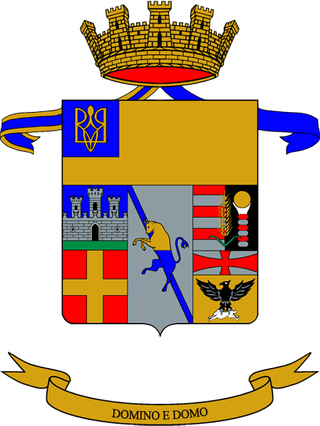
The 52nd Field Artillery Regiment "Torino" is an artillery regiment of the Italian Army trained for divisional artillery support. Since September 2020 the regiment is based together with the 8th Field Artillery Regiment "Pasubio" in Persano in Campania. The regiment is assigned to the army's Artillery Command.
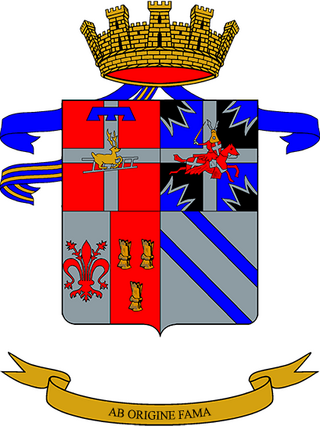
The 5th Field Artillery Regiment "Superga" is a field artillery regiment of the Italian Army. The regiment is the army's only multiple rocket launcher unit and equipped with M270A1 MLRS-I launchers. The regiment is based in Portogruaro in Veneto and assigned to the Artillery Command. The regiment is the Italian Army's senior artillery regiment and was formed in 1850 by the Royal Sardinian Army. In 1855-56 the regiment deployed six batteries to Crimea for the Crimean War and in 1859 it fought in the Second Italian War of Independence. In the 1860 it participated in the Sardinian campaign in Central and Southern Italy. In 1861 the regiment joined the Royal Italian Army and in 1866 it fought in the Third Italian War of Independence. During World War I the regiment served on the Italian front. In 1935 the regiment was assigned to the 1st Infantry Division "Superga", which in 1940 participated in the invasion of France. In fall 1942 the division was transferred to Tunisia for the Tunisian campaign. The division and its regiments surrendered there to the British forces on 12 May 1943.
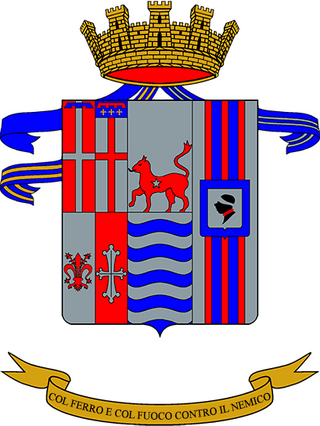
The 7th CBRN Defense Regiment "Cremona" is the Italian Army's CBRN defense unit. Today the regiment is based in Civitavecchia in Lazio and assigned to the Artillery Command. The regiment was formed in 1860 by the Royal Sardinian Army and its batteries participated in the same year in the Sardinian campaign in Central and Southern Italy. In 1861 the regiment joined the Royal Italian Army and in 1866 it fought in the Third Italian War of Independence. During World War I the regiment served on the Italian front. In 1939 the regiment was assigned to the 44th Infantry Division "Cremona", which was deployed in Corsica when the Armistice of Cassibile was announced on 8 September 1943. The division immediately went on the offensive against German forces trying to retreat through the island. The division then joined the Italian Co-belligerent Army and was reorganized as Combat Group "Cremona". Equipped with British weapons and materiel the group was assigned to the British V Corps and fought in the Allied 1945 spring offensive.
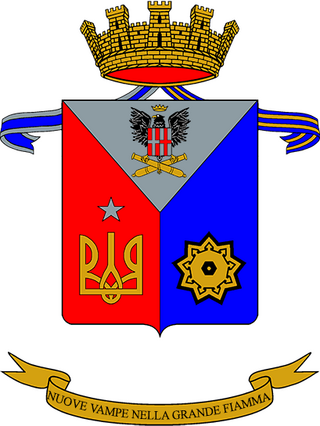
The 120th Motorized Artillery Regiment is an inactive field artillery regiment of the Italian Army, which was based in Palmanova in Friuli-Venezia Giulia. Originally an artillery regiment of the Royal Italian Army, the regiment was assigned in World War II to the 3rd Cavalry Division "Principe Amedeo Duca d'Aosta", with which the regiment was deployed to the Eastern Front, where division and regiment were destroyed during Operation Little Saturn. The unit was reformed in 1975 and disbanded 1991. The regimental anniversary falls, as for all Italian Army artillery regiments, on June 15, the beginning of the Second Battle of the Piave River in 1918.

The 108th Artillery Regiment "Cosseria" is an inactive field artillery regiment of the Italian Army, which was based in Casarsa della Delizia in Friuli-Venezia Giulia. Originally an artillery regiment of the Royal Italian Army, the regiment was assigned in World War II to the 5th Infantry Division "Cosseria", with which the regiment was deployed to the Eastern Front, where division and regiment were destroyed during Operation Little Saturn. The unit was reformed in 1976 and disbanded 10 years later. The regimental anniversary falls, as for all Italian Army artillery regiments, on June 15, the beginning of the Second Battle of the Piave River in 1918.

The 35th Artillery Regiment "Friuli" is an inactive field artillery regiment of the Italian Army, which was based in Pistoia in Tuscany. Originally an artillery regiment of the Royal Italian Army, the regiment was formed in 1915 and served in World War I, before being disbanded after the war. The regiment was reformed in 1939 and assigned in World War II to the 20th Infantry Division "Friuli", with which the regiment was deployed to Corsica. When the Armistice of Cassibile was announced on 8 September 1943 the division immediately battled retreating German Wehrmacht forces and then joined the Italian Co-belligerent Army. Equipped with British materiel the regiment entered the Combat Group "Friuli", which was assigned to the II Polish Corps for the Italian campaign.
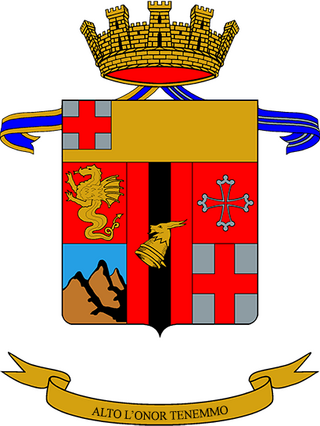
The 33rd Artillery Regiment "Acqui" is an inactive field artillery regiment of the Italian Army, which was based in L'Aquila in Abruzzo. Originally an artillery regiment of the Royal Italian Army, the regiment was formed in 1915 and served in World War I, before being disbanded after the war. The regiment was reformed in 1939 and assigned in World War II to the 33rd Infantry Division "Acqui", with which the regiment fought in the Greco-Italian War. The division and regiment were located on the Greek island of Cephalonia when the Armistice of Cassibile was announced on 8 September 1943. The division refused German demands to surrender and fought German forces landing on the island. On 22 September the division surrendered and afterwards the Germans shot the division's officers and most its troops.
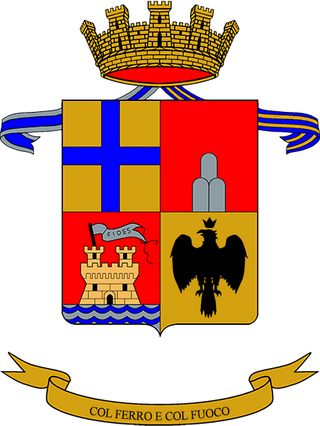
The 28th Artillery Regiment "Livorno" is an inactive field artillery regiment of the Italian Army, which was based in Tarcento in Friuli-Venezia Giulia. Originally an artillery regiment of the Royal Italian Army, the regiment was formed in 1912 and served in World War I on the Italian front. After the war the regiment was disbanded. In 1926 the regiment was reformed and in 1935 it was assigned to the 4th Infantry Division "Livorno". The division was deployed on Sicily, when the Allied landings began on 10 July 1943. In early August the remnants of the division were evacuated from Sicily and the regiment was in the process of being reformed, when German forces disbanded the division and its regiment after the Armistice of Cassibile was announced on 8 September 1943.

The 9th Artillery Regiment "Pistoia" is an inactive field artillery regiment of the Italian Army, which was based in Vercelli in Piedmont. The regiment was formed in 1861 by the Royal Italian Army and fought in 1866 in the Third Italian War of Independence. During World War I the regiment served on the Italian front. In 1935 the regiment was assigned to the 11th Infantry Division "Brennero". In December 1940 the division was transferred to Albania for the Greco-Italian War. After the German invasion of Greece in April 1941 the division remained in Greece on occupation duty until February 1943, when it moved to Albania to be reorganized as a motorized division. The division and its regiments dissolved after the announcement of the Armistice of Cassibile on 8 September 1943.

The 1st Artillery Regiment "Cacciatori delle Alpi" is an inactive field artillery regiment of the Italian Army, which was based in Bracciano in Lazio. The regiment was formed in 1871 by the Royal Italian Army. During World War I the regiment served on the Italian front. In 1935 the regiment was assigned to the 22nd Infantry Division "Cacciatori delle Alpi", with which the regiment served in the Greco-Italian War of World War II. In July 1941 the division was sent to occupied Yugoslavia on occupation duty. After the announcement of the Armistice of Cassibile on 8 September 1943 the division and its regiments were disbanded on 11 September by invading German forces.






















